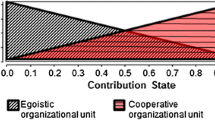Abstract.
Adaptive agents, playing the iterated Prisoner’s Dilemma (IPD) in a two-dimensional spatial setting and governed by Pavlovian strategies (“higher success-higher chance to stay”), are used to approach the problem of cooperation between self-interested individuals from a novel angle: We investigate the effect of different possible measures of success (MS) used by players to asses their performance in the game. These MS involve quantities such as: the player’s utilities U, his cumulative score (or “capital”) W, his neighborhood “welfare”, etc. To handle an imprecise concept like “success” the agents use fuzzy logic. The degree of cooperation, the “economic demography” and the “efficiency” attained by the system depend dramatically on the MS. Specifically, patterns of “segregation” or “exploitation” are observed for some MS. On the other hand, power laws, that may be interpreted as signatures of critical self-organization (SOC), constitute a common feature for all the MS.
Similar content being viewed by others
References
J. Maynard-Smith, E. Szathmary, The Major Transitions in Evolution (Oxford University Press, 1995)
J. Maynard-Smith, Evolution and the Theory of Games (Cambridge Univ. Press, 1982)
J. Maynard-Smith, G. Price, Nature (London) 146, 15 (1973)
R. Axelrod, The evolution of cooperation (Basic Books, New York, 1984)
J. Epstein, Complexity, Vol. 4, Number 2, November-December (1998)
M.A. Nowak, R. May, Nature (London) 359, 826 (1992)
D. Kraines, V. Kraines, Theory Decision 26, 47 (1988)
M. Domjan, B. Burkhard, The principles of learning and behaviour, 2nd edn., Chap. 5 (Monterey, CA: Brooks/Cole Publishing Company, 1986)
C. Wedekind, M. Milinski, Proc. Natl. Acad. Sci. USA 93, 2686 (1996)
M.A. Nowak, K. Sigmund, Nature (London) 364, 56 (1993)
H. Fort, J. Artificial Societies and Social Simulations JASSS (UK) 6
H. Fort, Phys. Rev. E 68, 026118 (2003)
L. Zadeh, Information and Control 8, 338 (1965)
L. Zadeh et al., “The Calculus of Fuzzy Restrictions”, in Fuzzy Sets and Applications to Cognitive and Decision Making Processes (Academic Press, New York, 1975), p. 1–39
P.E. Turner, L. Chao, Nature (London) 398, 441 (1999)
Indeed, the determination of the global minimum and maximum of W is not a trivial matter for an agent. However, we checked that changing Wmax (Wmin) by rough estimates doesn’t change results qualitatively
We checked that ordinary cellular automata, with synchronous dynamics, produce similar spatial patterns
S. Wolfram, Physica D 10, 1 (1984)
This will be analyzed in detail elsewhere
R.D. Putnam, Making democracy work. Civic traditions in modern Italy (Princeton, Princeton University Press, 1993)
J.F. Helliwell, R.D. Putnam, Eastern Economic J. 21(3), 295 (1995)
Author information
Authors and Affiliations
Corresponding author
Rights and permissions
About this article
Cite this article
Fort, H., Pérez, N. Economic demography in fuzzy spatial dilemmas and power laws. Eur. Phys. J. B 44, 109–113 (2005). https://doi.org/10.1140/epjb/e2005-00105-8
Received:
Published:
Issue Date:
DOI: https://doi.org/10.1140/epjb/e2005-00105-8




